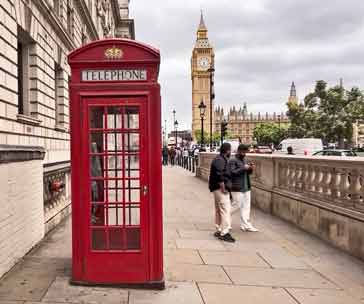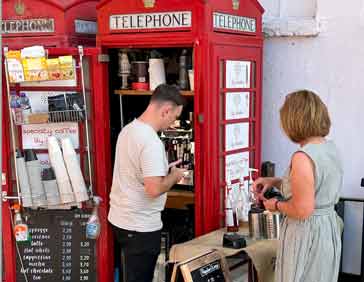The Red Telephone Box: A British Icon
The red telephone box has been a part of British life for very many years, and now as the need for them falls, they are being used for many other purposes.
Landline telephones Includes:
British red telephone boxes
The red telephone box or call box, is a quintessential symbol of British culture, and it has graced the nation's streets for over a century.
These red telephone boxes were once an essential element of the landline based telephone system because not everyone owned their own telephone, and people needed to make calls.

The call boxes were placed on streets in residential areas as well as in towns and cities - on street corners or other areas where they were obvious but not causing obstructions.
Now with most families having their own phones and the rise of the mobile phone, they are being used far less.
Many are falling into disrepair or they are being used for other purposes. Nevertheless red telephone boxes are still a tourist attraction on London, especially near famous buildings like the Houses of Parliament.
Video: The Iconic British Red Telephone Call Box
A Design for the Ages
Sir Giles Gilbert Scott, a renowned architect responsible for iconic landmarks like Liverpool Cathedral and Battersea Power Station, won a competition held by the General Post Office in 1924 to design a new generation of telephone kiosks.
His winning design, the K2, was a departure from the drab, utilitarian boxes that had previously dotted the landscape.
The K2 was a sleek, modernist structure with a distinctive shape and a pitched roof. Its bold red color, a nod to the British Post Office's livery, made it instantly recognizable.
The design was not only functional but also aesthetically pleasing, fitting into the urban and rural environment.
Red telephone box evolution
Over the years, the red telephone box has undergone several iterations, each adapting to changing technological and social needs.
The K6 model, introduced in 1935, became the most widely recognized and beloved design. It featured a larger interior, improved ventilation, and a more robust construction.
As technology advanced, so too did the telephone box. Payphones were introduced, allowing users to make calls without coins.
Later, card phones became the norm, offering greater convenience and flexibility. However, with the rise of mobile phones, the traditional red telephone box began to decline in popularity.

A Symbol of British Culture
Despite its declining functionality, the red telephone box remains a cherished symbol of British culture.
Its distinctive shape and vibrant colour have made it a popular subject for photographers, artists, and filmmakers. It has been featured in countless movies, television shows, and advertisements, often representing the quintessential British experience.
The Future of the Red Telephone Box
While the traditional role of the red telephone box has diminished, its cultural significance endures. Many people believe that these iconic structures should be preserved as part of Britain's heritage.
Many red telephone boxes have been repurposed to serve new functions. Some have been transformed into miniature libraries, art galleries, or even cafes. Others have been preserved as historical artifacts or incorporated into private gardens.

Initiatives have been launched to restore and maintain historic telephone boxes, ensuring that they continue to grace the nation's streets for generations to come.
The red telephone box is more than just a piece of infrastructure; it is a symbol of British ingenuity, design, and cultural identity. Its enduring legacy is a testament to its timeless appeal.
 Written by Ian Poole .
Written by Ian Poole .
Experienced electronics engineer and author.
More History:
Radio history timeline
History of the radio
Ham radio history
Coherer
Crystal radio
Magnetic detector
Spark transmitter
Morse telegraph
Valve / tube history
PN junction diode invention
Transistor
Integrated circuit
Quartz crystals
Classic radios
Mobile telecoms history
Vintage mobile phones
Return to History menu . . .


